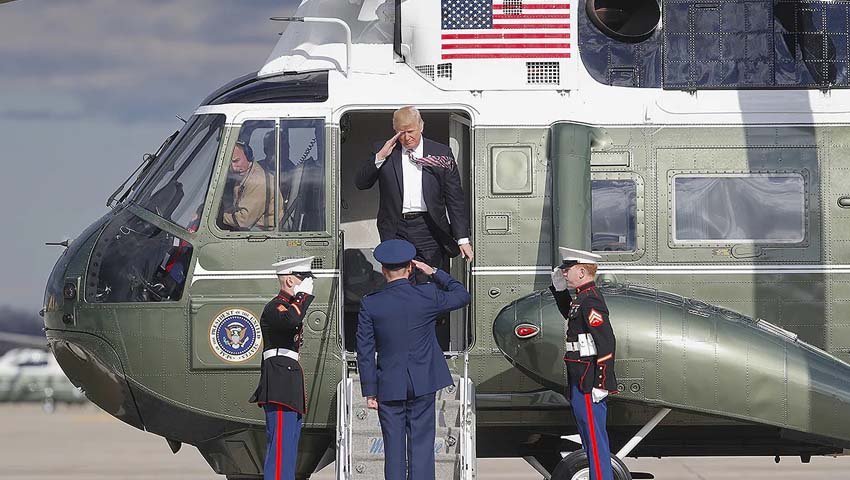Congress has approved US President Donald Trump’s US$738 billion defence budget as part of the administration’s US$1.4 trillion FY2020 budget, with countering the rise of China and a resurgent Russia key focal points of the record defence expenditure.
To continue reading the rest of this article, please log in.
Create free account to get unlimited news articles and more!
Despite impeachment proceedings in the House of Representatives, the fiery US President Donald Trump has sought to capitalise on a surging US economy to pass yet another increase for the US defence budget – expected to see the Pentagon receiving US$738 billion for FY2020.
While the figure is less than the US$750 billion President Trump called for earlier this year, the US$738 billion figure will still see a major ramp up in the modernisation, recapitalisation and expansion of the US military at a time of increasing great power rivalry.
Ranking Republican law maker on the House appropriations defense subcommittee Ken Calvert welcomed the US$20 billion increase over the preceding 2019 budget, explaining: "The bill increases funding for operations and maintenance, and procurement for the next generation of equipment to ensure our men and women in uniform always have the tactical advantage."
This was reinforced by Senate appropriations committee chairman Richard Shelby of Alabama, who stated the deal would see "robust investment in rebuilding our military and secures significant funds for the President’s border wall system".
The 2020 National Defense Autorization Act will see a number of major acquisition, organisational restructures and modernisation programs to support America's shift away from decades of conflict in Afghanistan and the Middle East, with a US$15 billion increase in the procurement budget, bringing the Pentagon's total acquisition budget to US$146 billion.
More planes, ships and upgraded ground vehicles
The act sees US$1.87 billion for aviation acquisition programs, including the purchase of 98 F-35 aircraft, 20 more than requested by President Trump, and eight Boeing F-15EX aircraft to recapitalise the Air Force and Air National Guard's F-15C/D fleets respectively.
Additionally, the figure will support the acquisition of 12 KC-46A tanker aircraft as part of the ongoing aerial refuelling recapitalisation program, 24 F/A-18 E/F Block III Super Hornets for the US Navy, nine P-8A Poseidon maritime patrol/anti-submarine aircraft and 74 UH-60 Black Hawk helicopters.
The US Navy was a major winner out of the increased budget, with US $23.9 billion approved for the acquisition of 14 warships, including three Flight III DDG-51 Arleigh Burke Class guided missile destroyers, a guided missile frigate, a single America Class landing helicopter dock and a single LX-R amphibious transport dock to support the US Marines.
Additionally, the US Navy will receive an Austal designed expeditionary fast transport ship, two replenishment oilers, two tugs and the next Ford Class supercarrier. However, the funds will provide for three Virginia Class fast attack submarines, one less than the President requested.
The US Navy's ambitious plans to replace the Super Hornets saw a major hit, with the requested US$20.7 million rejected, with just US$7.1 million approved to support the development of the US Navy's F/A-XX sixth-generation fighter concept.
Both the US Army and Marine Corps will benefit from US$1.7 billion for M1A2 SEPv3 upgrades for their respective fleets of Abrams main battle tanks, and US$1.5 billion approved for the acquisition of additional Joint Light Tactical Vehicles and a program increase of US$250 million to support a 30mm cannon upgrade for the US Army's Stryker armoured vehicles.
Missile defence, border security and election security
The 2020 National Defense Autorization Act is also expected to fully fund the US$1.2 billion request for national security space launch, and provide US$10.4 billion to the Missile Defense Agency ― including US$108 million for a space-based sensor array to focus on tracking hypersonic and ballistic missiles.
Not leaving empty handed, the Democrats secured a number of wins outside the act, seeing US$425 million for election security grants ahead of the 2020 presidential election – a key focus for the Democrats.
This also saw the White House receiving US$1.38 billion in Homeland Security funding to support the President's border wall along the US-Mexico border wall – significantly less than the US$5 billion the President original requested for the contentious program.
Get involved with the discussion in the comments section below, or get in touch with

 Login
Login







